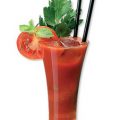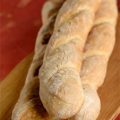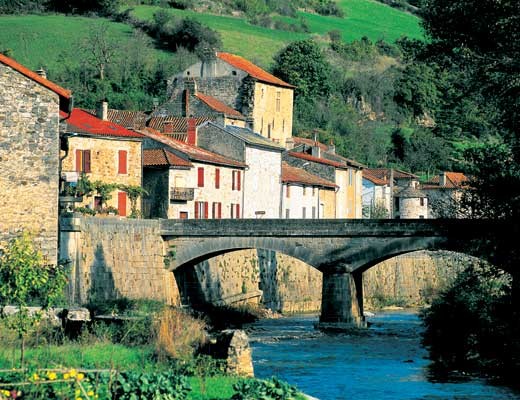 Roquefort cheeseCharles de Gaulle once joked: «Как можно управлять страной, в которой столько же сортов сыра, сколько дней в году!» Однако, назвав немалую цифру, явно поскромничал. Их не менее 500, хотя точного количества, как, впрочем, и всех названий, не знает ни один француз. Чтобы навести в этом вопросе порядок, великие кулинары даже попытались составить «Карту французских сыров», но места на географической карте хватило только шестидесяти самым известным сортам. Очень символично, что центральное место на ней (как по местонахождению сыроварен, так и по значимости) занимает рокфор, или Мсье Фромаж (фр. fromage — «сыр»), как его уважительно называют французы. Его вкусовые качества оценены по достоинству во всем мире. Наверное, поэтому, лишенные этого деликатеса австралийцы, столь рьяно добивались официального разрешения правительства на право продажи сыра на Зеленом континенте, куда долгие годы ввоз непастеризованного продукта был запрещен. Но настойчивость гурманов сломила упорство чиновников. И в октябре прошлого года министр по делам здравоохранения все-таки объявил о снятии эмбарго. Особые приметы«Давно коронованный у себя на родине рокфор — одна из самых раскрученных сырных марок, фактически ставшая родоначальником семейства «голубых сыров», — говорит шеф-повар ресторана Portofino Евгений Запольский.— И главное, это сыр абсолютно узнаваемый, хотя к его специфическому, пикантному вкусу даже искушенные специалисты относятся по-разному». Для сегодняшнего российского гурмана знаменитый сыр рокфор не диковинка: без этого деликатеса не обходится меню ни одного дорогого французского ресторана или гастрономического бутика, да и на прилавках отечественных магазинов он давно уже не редкость. Однако оценить его качество и происхождение, не будучи профессионаломаффинером (так во Франции называют сыроваров), практически невозможно. «Доступные сегодняшнему покупателю немецкий сыр из коровьего молока бергадер и французский сент-агюр почти неотличимы от знаменитого собрата. И для рядового потребителя главным отличием между этими : так, немецкий аналог рокфора на 30—40 % дешевле своего прославленного французского родственника», — рассказывает корпоративный шеф-повар компании «Восток-Запад Сервис» Константин Жбаков. Присутствие на рынке разных видов рокфора никак не увязывается с общеизвестным фактом глубокой засекреченности уходящего корнями в глубь веков Великого сыроварного ноу-хау и вселяет вполне понятные сомнения по поводу качества незаконно претендующих на королевский трон сыров-«самозванцев». Тем же, кто хочет полакомиться настоящим рокфором, помогут сориентироваться его упаковка и цена. Доставляемый в Россию авиа- или автотранспортом драгоценный товар — продукт компании «Сосьете» (Societe), занимающейся его производством без малого полтора века, о чем на упаковке имеется соответствующая надпись «Depuis 1863». Кстати, за выдающиеся заслуги на ниве элитного сыроварения еще в далеком 1867 году фирма «Сосьете» была удостоена ордена Почетного легиона. Сыр поступает в продажу в пластиковых вакуумных упаковках весом 100 и 150 г или в виде облаченных в двойную пергаментную бумагу и пищевую пленку сырных «полуголов» (полудисков) весом 1 и 1,25 кг для продажи на развес. Уникальная упаковка одновременно не промокает и дышит, не давая сыру задохнуться.
Roquefort cheeseCharles de Gaulle once joked: «Как можно управлять страной, в которой столько же сортов сыра, сколько дней в году!» Однако, назвав немалую цифру, явно поскромничал. Их не менее 500, хотя точного количества, как, впрочем, и всех названий, не знает ни один француз. Чтобы навести в этом вопросе порядок, великие кулинары даже попытались составить «Карту французских сыров», но места на географической карте хватило только шестидесяти самым известным сортам. Очень символично, что центральное место на ней (как по местонахождению сыроварен, так и по значимости) занимает рокфор, или Мсье Фромаж (фр. fromage — «сыр»), как его уважительно называют французы. Его вкусовые качества оценены по достоинству во всем мире. Наверное, поэтому, лишенные этого деликатеса австралийцы, столь рьяно добивались официального разрешения правительства на право продажи сыра на Зеленом континенте, куда долгие годы ввоз непастеризованного продукта был запрещен. Но настойчивость гурманов сломила упорство чиновников. И в октябре прошлого года министр по делам здравоохранения все-таки объявил о снятии эмбарго. Особые приметы«Давно коронованный у себя на родине рокфор — одна из самых раскрученных сырных марок, фактически ставшая родоначальником семейства «голубых сыров», — говорит шеф-повар ресторана Portofino Евгений Запольский.— И главное, это сыр абсолютно узнаваемый, хотя к его специфическому, пикантному вкусу даже искушенные специалисты относятся по-разному». Для сегодняшнего российского гурмана знаменитый сыр рокфор не диковинка: без этого деликатеса не обходится меню ни одного дорогого французского ресторана или гастрономического бутика, да и на прилавках отечественных магазинов он давно уже не редкость. Однако оценить его качество и происхождение, не будучи профессионаломаффинером (так во Франции называют сыроваров), практически невозможно. «Доступные сегодняшнему покупателю немецкий сыр из коровьего молока бергадер и французский сент-агюр почти неотличимы от знаменитого собрата. И для рядового потребителя главным отличием между этими : так, немецкий аналог рокфора на 30—40 % дешевле своего прославленного французского родственника», — рассказывает корпоративный шеф-повар компании «Восток-Запад Сервис» Константин Жбаков. Присутствие на рынке разных видов рокфора никак не увязывается с общеизвестным фактом глубокой засекреченности уходящего корнями в глубь веков Великого сыроварного ноу-хау и вселяет вполне понятные сомнения по поводу качества незаконно претендующих на королевский трон сыров-«самозванцев». Тем же, кто хочет полакомиться настоящим рокфором, помогут сориентироваться его упаковка и цена. Доставляемый в Россию авиа- или автотранспортом драгоценный товар — продукт компании «Сосьете» (Societe), занимающейся его производством без малого полтора века, о чем на упаковке имеется соответствующая надпись «Depuis 1863». Кстати, за выдающиеся заслуги на ниве элитного сыроварения еще в далеком 1867 году фирма «Сосьете» была удостоена ордена Почетного легиона. Сыр поступает в продажу в пластиковых вакуумных упаковках весом 100 и 150 г или в виде облаченных в двойную пергаментную бумагу и пищевую пленку сырных «полуголов» (полудисков) весом 1 и 1,25 кг для продажи на развес. Уникальная упаковка одновременно не промокает и дышит, не давая сыру задохнуться. 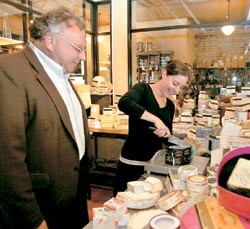 In the center of the old-styleThe manuscript of the branded packaging also indicates the place and method of production of Roquefort "Affine" en Caves Naturelles, that is, matured in the natural stone grottoes of Combalou in the commune of Roquefort-sur-Suzlon. The authenticity of the fact that the cheese is made from fatty sheep's milk (more than 50%) is confirmed by the red trademark in the form of a sheep silhouette enclosed in an oval. The next landmark is the truly royal price. Among the impressive number of cheeses presented in the assortment of the Seventh Continent store, Roquefort is the most expensive: the cost of a 100-gram segment proudly lying on the shelf is 189 rubles 90 kopecks. The price range in the Hediard gastronomic boutique is similar. For comparison: Roquefort's closest relatives, Dorblu and Camembert, are offered at a price almost 100 rubles less for the same amount. Bought in bulk, Roquefort will cost a little less: the classic variety (52% fat; a larger half-disk in a package with green letters) is sold here for 1,490 rubles per 1 kg. However, high store prices for Roquefort pale in comparison with sky-high restaurant prices: the cost of the "Large Cheese Plate" in the dessert menu of the French restaurant Carre Blanc, which, along with sixteen other types of cheese, naturally includes Roquefort, is close to the store price of 1 kg of elite cheese. The Patriarch Among CheesesEvery famous cheese necessarily has its own legend. Roquefort has one too. Although much of it, starting with the widespread version of its origin, seems credible only to the French themselves. For most people, however, it is nothing more than a fairy tale. So, a certain shepherd, seeing a young beauty, forgot about his breakfast - a piece of young sheep's cheese and a piece of rye bread and rushed to catch up with her. After some time, the young frivolous fellow returned to the abandoned food and - oh miracle! - discovered that it had turned into a piece of the most perfect of cheeses. The unreliability of this story is obvious: innocent shepherdesses thinking exclusively about the romantic side of life inhabited only the public consciousness of the age of sentimentalism, but in reality they never existed. One can also question the very date of birth of the cheese. The French say that Roquefort is 900 years old, citing as historical evidence the quitrent lists, essentially a list of products brought by peasants to their overlord as tribute. This information does not allow us to speak accurately about the scale of Roquefort production and its original taste, but it does allow us to judge that this cheese did not have any special gastronomic significance at that time - peasants shared with the feudal lords not delicacies, but what they ate themselves. However, the number 900 somehow magically makes the ambitious French convince everyone that Roquefort is the oldest of the "pedigree" cheeses in the world. Although this is not true at all. Their desire to be the first in this matter is understandable, but it is unclear why they forget about the French cheese Maroli, which, judging by the surviving monastery records, is a hundred years older than Roquefort. Perhaps the reason why the French give the latter the palm lies in its exceptional taste.
In the center of the old-styleThe manuscript of the branded packaging also indicates the place and method of production of Roquefort "Affine" en Caves Naturelles, that is, matured in the natural stone grottoes of Combalou in the commune of Roquefort-sur-Suzlon. The authenticity of the fact that the cheese is made from fatty sheep's milk (more than 50%) is confirmed by the red trademark in the form of a sheep silhouette enclosed in an oval. The next landmark is the truly royal price. Among the impressive number of cheeses presented in the assortment of the Seventh Continent store, Roquefort is the most expensive: the cost of a 100-gram segment proudly lying on the shelf is 189 rubles 90 kopecks. The price range in the Hediard gastronomic boutique is similar. For comparison: Roquefort's closest relatives, Dorblu and Camembert, are offered at a price almost 100 rubles less for the same amount. Bought in bulk, Roquefort will cost a little less: the classic variety (52% fat; a larger half-disk in a package with green letters) is sold here for 1,490 rubles per 1 kg. However, high store prices for Roquefort pale in comparison with sky-high restaurant prices: the cost of the "Large Cheese Plate" in the dessert menu of the French restaurant Carre Blanc, which, along with sixteen other types of cheese, naturally includes Roquefort, is close to the store price of 1 kg of elite cheese. The Patriarch Among CheesesEvery famous cheese necessarily has its own legend. Roquefort has one too. Although much of it, starting with the widespread version of its origin, seems credible only to the French themselves. For most people, however, it is nothing more than a fairy tale. So, a certain shepherd, seeing a young beauty, forgot about his breakfast - a piece of young sheep's cheese and a piece of rye bread and rushed to catch up with her. After some time, the young frivolous fellow returned to the abandoned food and - oh miracle! - discovered that it had turned into a piece of the most perfect of cheeses. The unreliability of this story is obvious: innocent shepherdesses thinking exclusively about the romantic side of life inhabited only the public consciousness of the age of sentimentalism, but in reality they never existed. One can also question the very date of birth of the cheese. The French say that Roquefort is 900 years old, citing as historical evidence the quitrent lists, essentially a list of products brought by peasants to their overlord as tribute. This information does not allow us to speak accurately about the scale of Roquefort production and its original taste, but it does allow us to judge that this cheese did not have any special gastronomic significance at that time - peasants shared with the feudal lords not delicacies, but what they ate themselves. However, the number 900 somehow magically makes the ambitious French convince everyone that Roquefort is the oldest of the "pedigree" cheeses in the world. Although this is not true at all. Their desire to be the first in this matter is understandable, but it is unclear why they forget about the French cheese Maroli, which, judging by the surviving monastery records, is a hundred years older than Roquefort. Perhaps the reason why the French give the latter the palm lies in its exceptional taste.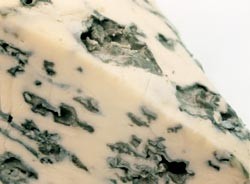 Spicy details: Freezing Roquefort,как и нагревать, нежелательно, — считает Константин Жбаков. — Конечно, за счет высокой жирности этот сорт способен выдерживать воздействие низких температур, но переохлаждение все же портит его потребительские качества». Однако если купленный кусок сыра не может быть съеден сразу, то его лучше держать в холодильнике при температуре +2—6°С в банке со стеклянной крышкой или завернутым в пленку, фольгу или пергаментную бумагу. Только таким образом можно изолировать ценный продукт от воздействия посторонних запахов и одновременно от губительной для него влаги и высыхания: влажный маслянистый сыр имеет свойство отдавать жидкость. Также не следует забывать о том, что во время хранения не заканчивается процесс дозревания рокфора, он продолжает обогащаться пикантным вкусом. Свежий рокфор внутри мягковат, сочетает в себе остринку и свежесть и лишен неприятного послевкусия. Чаще всего его подают как закуску к вину в чистом виде или с другими сортами сыра. Для резки рокфора используется придуманное на его родине приспособление, называемое la roquefortaise —«рокфортезка». Она представляет собой станок, режущим элементом которого является натянутая проволока. Минимальная режущая поверхность позволяет не нарушать структуру нежной плесени внутри сыра, которую легко смять обычным, даже хорошо наточенным ножом. Сырную нарезку принято есть по часовой стрелке. Разные сорта сыра выкладываются на тарелке по кругу от самого нейтрального — сливочного козьего до самого острого — рокфора: другой вкус после него почувствовать сложно. Нередко знатоку достаточно одной тонкой пластинки рокфора, чтобы насладиться его необычным вкусом в сочетании с вином. Поэтому рокфор хоть и заказывается часто, потребляется, как и положено деликатесу, в небольших количествах. В отношении рокфора действует правило классических сырных сочетаний. С ним прекрасно гармонируют сладости: мед, конфитюр, орехи и свежие фрукты (манго, груши, виноград, клубника, смородина и многие другие за исключением цитрусовых). Весьма необычное сочетание соленого со сладким по достоинству оценено многими — однако границы сочетаемости двух полярных вкусов каждый определяет сам. Выигрышна и комбинация рокфора с овощами и зеленью — сыр хорошо гармонирует с оливковым маслом и перцем в составе разнообразных салатов. Как все продукты с ярко выраженным, концентрированным вкусом, рокфор прекрасно дополняется нейтральной пищей, удачно оттеняется хлебом, и не только белым, но и ржаным. В дорогих итальянских ресторанах терпкий вкус рокфора используют в составе пасты и пиццы. Рокфор употребляется как в натуральном виде, так и при изготовлении блюд — соусов, супов, фондю с сырами более сдержанного вкуса. Резкий вкус классических холодных и горячих соусов на основе рокфора хорошо сочетается с нейтральными овощами, например с капустой или картошкой. С соусом из рокфора и других «голубых сыров» подаются куриные крылышки, утиная грудка, креветки. Однако ряд особенностей капризного «короля сыров» затрудняет его использование в кулинарии. Рокфор плохо переносит тепловую обработку, поэтому при изготовлении, например, соусов он добавляется в последнюю очередь. Кроме того, рокфор и в виде соуса имеет свойство настаиваться. По этой причине повара нередко отказываются от его использования в кулинарии, стараясь перейти на дорблю как на менее острый и более дешевый сыр. Какими напитками запивается сыр, обладающий столь самобытным вкусом? Любители точных инструкций будут разочарованы.
Spicy details: Freezing Roquefort,как и нагревать, нежелательно, — считает Константин Жбаков. — Конечно, за счет высокой жирности этот сорт способен выдерживать воздействие низких температур, но переохлаждение все же портит его потребительские качества». Однако если купленный кусок сыра не может быть съеден сразу, то его лучше держать в холодильнике при температуре +2—6°С в банке со стеклянной крышкой или завернутым в пленку, фольгу или пергаментную бумагу. Только таким образом можно изолировать ценный продукт от воздействия посторонних запахов и одновременно от губительной для него влаги и высыхания: влажный маслянистый сыр имеет свойство отдавать жидкость. Также не следует забывать о том, что во время хранения не заканчивается процесс дозревания рокфора, он продолжает обогащаться пикантным вкусом. Свежий рокфор внутри мягковат, сочетает в себе остринку и свежесть и лишен неприятного послевкусия. Чаще всего его подают как закуску к вину в чистом виде или с другими сортами сыра. Для резки рокфора используется придуманное на его родине приспособление, называемое la roquefortaise —«рокфортезка». Она представляет собой станок, режущим элементом которого является натянутая проволока. Минимальная режущая поверхность позволяет не нарушать структуру нежной плесени внутри сыра, которую легко смять обычным, даже хорошо наточенным ножом. Сырную нарезку принято есть по часовой стрелке. Разные сорта сыра выкладываются на тарелке по кругу от самого нейтрального — сливочного козьего до самого острого — рокфора: другой вкус после него почувствовать сложно. Нередко знатоку достаточно одной тонкой пластинки рокфора, чтобы насладиться его необычным вкусом в сочетании с вином. Поэтому рокфор хоть и заказывается часто, потребляется, как и положено деликатесу, в небольших количествах. В отношении рокфора действует правило классических сырных сочетаний. С ним прекрасно гармонируют сладости: мед, конфитюр, орехи и свежие фрукты (манго, груши, виноград, клубника, смородина и многие другие за исключением цитрусовых). Весьма необычное сочетание соленого со сладким по достоинству оценено многими — однако границы сочетаемости двух полярных вкусов каждый определяет сам. Выигрышна и комбинация рокфора с овощами и зеленью — сыр хорошо гармонирует с оливковым маслом и перцем в составе разнообразных салатов. Как все продукты с ярко выраженным, концентрированным вкусом, рокфор прекрасно дополняется нейтральной пищей, удачно оттеняется хлебом, и не только белым, но и ржаным. В дорогих итальянских ресторанах терпкий вкус рокфора используют в составе пасты и пиццы. Рокфор употребляется как в натуральном виде, так и при изготовлении блюд — соусов, супов, фондю с сырами более сдержанного вкуса. Резкий вкус классических холодных и горячих соусов на основе рокфора хорошо сочетается с нейтральными овощами, например с капустой или картошкой. С соусом из рокфора и других «голубых сыров» подаются куриные крылышки, утиная грудка, креветки. Однако ряд особенностей капризного «короля сыров» затрудняет его использование в кулинарии. Рокфор плохо переносит тепловую обработку, поэтому при изготовлении, например, соусов он добавляется в последнюю очередь. Кроме того, рокфор и в виде соуса имеет свойство настаиваться. По этой причине повара нередко отказываются от его использования в кулинарии, стараясь перейти на дорблю как на менее острый и более дешевый сыр. Какими напитками запивается сыр, обладающий столь самобытным вкусом? Любители точных инструкций будут разочарованы. 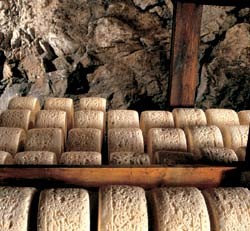 Experimenters, on the contrary, will be inspired by the spacefor creativity. Sweet wines like Cahors, Sauternes and Port, liqueur wines like Muscat, dry reds and sweet whites... The recommendations are so contradictory that it seems you will have to look for the perfect taste on your own. Natives of France, familiar with the great cheese firsthand, are firmly convinced that the land that gave birth to it itself took care of the ideal complement to Roquefort, having given people mineral waters from local springs - in particular, Kezac water and Chaud-zeig from a hot (over 80°C) spring. But the well-known Casanova advised those seeking to "mature the recently emerged feeling" to treat the ladies to Roquefort and the famous Burgundy wine Chambertin. The choice can only be limited by culinary fantasy. Property of the residents of RoquefortMany lovers and experts believe that Roquefort generally stands out from all other cheeses. It's all about the production features. According to the decree of Charles VI of 1411, only residents of the town of Roquefort have the right to make real cheese called Roquefort. They prepare it from sheep's milk, and farmers specifically limit the animals' drinking so that their milk acquires increased fat content.
Experimenters, on the contrary, will be inspired by the spacefor creativity. Sweet wines like Cahors, Sauternes and Port, liqueur wines like Muscat, dry reds and sweet whites... The recommendations are so contradictory that it seems you will have to look for the perfect taste on your own. Natives of France, familiar with the great cheese firsthand, are firmly convinced that the land that gave birth to it itself took care of the ideal complement to Roquefort, having given people mineral waters from local springs - in particular, Kezac water and Chaud-zeig from a hot (over 80°C) spring. But the well-known Casanova advised those seeking to "mature the recently emerged feeling" to treat the ladies to Roquefort and the famous Burgundy wine Chambertin. The choice can only be limited by culinary fantasy. Property of the residents of RoquefortMany lovers and experts believe that Roquefort generally stands out from all other cheeses. It's all about the production features. According to the decree of Charles VI of 1411, only residents of the town of Roquefort have the right to make real cheese called Roquefort. They prepare it from sheep's milk, and farmers specifically limit the animals' drinking so that their milk acquires increased fat content.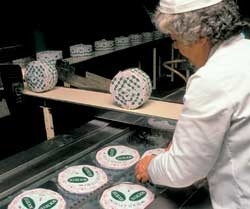 Fresh sheep's milk is heated to 26°C andrennet is added. Rennet is one of the sections of the sheep's stomach, distinguished by a high concentration of enzymes. For Roquefort, the rennet of five- to six-month-old lambs is used (by the way, this is the basis for periodic claims made against Roquefort producers by various activists of movements for the ethical treatment of animals). After an hour and a half, the soured milk is heated until it separates into whey and cheese curd, the latter is separated and cut into pieces the size of a walnut. These pieces are laid out in molds. The size of the molds is strictly regulated, since the size and configuration of the Roquefort heads are important signs of its authenticity. So, these molds are 8.7 cm high and 21 cm in diameter. So far, it would seem, nothing unusual. But here is the first detail that makes Roquefort Roquefort. Before placing the cheese curd in the mold, moldy bread crumbs are poured onto its bottom. And exactly the same crumbs are sprinkled on the curd before closing the mold. This is how mold gets into Roquefort. From this moment on, it is called a delicacy. Anyone who has held a moldy piece of bread in their hands has seen the mold "penicillium roqueforti". It acquires nobility and a blue-green color when sown in the cheese curd. There are no special strains of this mold, bred in time immemorial by medieval alchemists. The miracle of Roquefort lies not in some unseen ingredients, but in their hitherto unseen combination. The most important and at the same time truly inimitable detail of the cheese production is its aging in the caves of Mount Combalou, which is located in the central part of France.
Fresh sheep's milk is heated to 26°C andrennet is added. Rennet is one of the sections of the sheep's stomach, distinguished by a high concentration of enzymes. For Roquefort, the rennet of five- to six-month-old lambs is used (by the way, this is the basis for periodic claims made against Roquefort producers by various activists of movements for the ethical treatment of animals). After an hour and a half, the soured milk is heated until it separates into whey and cheese curd, the latter is separated and cut into pieces the size of a walnut. These pieces are laid out in molds. The size of the molds is strictly regulated, since the size and configuration of the Roquefort heads are important signs of its authenticity. So, these molds are 8.7 cm high and 21 cm in diameter. So far, it would seem, nothing unusual. But here is the first detail that makes Roquefort Roquefort. Before placing the cheese curd in the mold, moldy bread crumbs are poured onto its bottom. And exactly the same crumbs are sprinkled on the curd before closing the mold. This is how mold gets into Roquefort. From this moment on, it is called a delicacy. Anyone who has held a moldy piece of bread in their hands has seen the mold "penicillium roqueforti". It acquires nobility and a blue-green color when sown in the cheese curd. There are no special strains of this mold, bred in time immemorial by medieval alchemists. The miracle of Roquefort lies not in some unseen ingredients, but in their hitherto unseen combination. The most important and at the same time truly inimitable detail of the cheese production is its aging in the caves of Mount Combalou, which is located in the central part of France.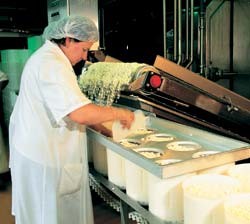 Nowadays Roquefort comes in two types -industrially produced, in a dairy plant, and farm-made, that is, hand-made. But in both cases, it is aged in a limestone cave. Numerous cracks in the rocks maintain a constant temperature in the range from 4 to 7°C, fresh air and constant humidity, which are ideal conditions for the growth of the penicillin fungus. Today, in the caves, which have been expanded and have a volume of only 90 thousand cubic meters, 16 thousand tons of Roquefort ripen annually. So, the cheese ready for ripening in a form is rubbed with dry salt, and then pierced with long needles, making up to 60 punctures in each head. This is done to prevent excessive mold formation on the outside of the cheese and, conversely, to provide good conditions for its germination inside. The product is aged for 3 months, and all this time the condition of its surface is constantly monitored, if necessary, cleaning it with a knife. The minimum permissible aging period is one month, the maximum is 5. During this time, the taste and smell of Roquefort undergo significant changes. At an early stage, Roquefort, like most sheep's milk cheeses, has a characteristic sharp taste. But after 60 days, the taste completely disappears, but the development of the cheese does not stop there. By the fifth month of aging, it acquires a sharp, very sharp taste and smell, which in the sixth month are modified into an almost indecent, moldy bouquet, allowing six-month Roquefort to be classified as over-aged. And here everything depends on the conscience of the supplier. Yes, that's right! It is clear that unripe or over-ripe cheese is sold cheaper than cheese of ideal maturity. Consequently, suppliers have some temptations. And if unripened cheese still has some chance of reaching the required condition, at least in the back room of a grocery store, then overripe cheese can simply discourage any interest in it. For those who want to enjoy the ideal Roquefort, it is best to buy cheese aged from May to December.
Nowadays Roquefort comes in two types -industrially produced, in a dairy plant, and farm-made, that is, hand-made. But in both cases, it is aged in a limestone cave. Numerous cracks in the rocks maintain a constant temperature in the range from 4 to 7°C, fresh air and constant humidity, which are ideal conditions for the growth of the penicillin fungus. Today, in the caves, which have been expanded and have a volume of only 90 thousand cubic meters, 16 thousand tons of Roquefort ripen annually. So, the cheese ready for ripening in a form is rubbed with dry salt, and then pierced with long needles, making up to 60 punctures in each head. This is done to prevent excessive mold formation on the outside of the cheese and, conversely, to provide good conditions for its germination inside. The product is aged for 3 months, and all this time the condition of its surface is constantly monitored, if necessary, cleaning it with a knife. The minimum permissible aging period is one month, the maximum is 5. During this time, the taste and smell of Roquefort undergo significant changes. At an early stage, Roquefort, like most sheep's milk cheeses, has a characteristic sharp taste. But after 60 days, the taste completely disappears, but the development of the cheese does not stop there. By the fifth month of aging, it acquires a sharp, very sharp taste and smell, which in the sixth month are modified into an almost indecent, moldy bouquet, allowing six-month Roquefort to be classified as over-aged. And here everything depends on the conscience of the supplier. Yes, that's right! It is clear that unripe or over-ripe cheese is sold cheaper than cheese of ideal maturity. Consequently, suppliers have some temptations. And if unripened cheese still has some chance of reaching the required condition, at least in the back room of a grocery store, then overripe cheese can simply discourage any interest in it. For those who want to enjoy the ideal Roquefort, it is best to buy cheese aged from May to December. What does this Roquefort look like?On top it is covered with a shiny white crust, always slightly moist. Its flesh is slightly oily, blue mold forms small cavities. Hand-made cheese is distinguished by the fact that the mold inside is unevenly distributed. The smell of Roquefort is very complex and difficult to describe. We can only say that it should contain two main tones - a powerful, pronounced smell of sheep's milk and a light, unobtrusive smell of mold. The remaining half-tones depend only on the development of your sense of smell and imagination. Most people talk about the smell of hazelnuts, poetic natures it reminds them of autumn leaf fall, and originals - a working copy machine. The taste of Roquefort is also ambiguous. It is different in different places of the cheese head. The richest - in the center, since this is where most of the mold is located. The most restrained is felt near the crust. This difference has given rise to a unique etiquette for cutting Roquefort. Each piece must have a crust and contain both the middle and outer parts of the head. It is better to start eating this slice from the less bland edge to the more spicy one.
What does this Roquefort look like?On top it is covered with a shiny white crust, always slightly moist. Its flesh is slightly oily, blue mold forms small cavities. Hand-made cheese is distinguished by the fact that the mold inside is unevenly distributed. The smell of Roquefort is very complex and difficult to describe. We can only say that it should contain two main tones - a powerful, pronounced smell of sheep's milk and a light, unobtrusive smell of mold. The remaining half-tones depend only on the development of your sense of smell and imagination. Most people talk about the smell of hazelnuts, poetic natures it reminds them of autumn leaf fall, and originals - a working copy machine. The taste of Roquefort is also ambiguous. It is different in different places of the cheese head. The richest - in the center, since this is where most of the mold is located. The most restrained is felt near the crust. This difference has given rise to a unique etiquette for cutting Roquefort. Each piece must have a crust and contain both the middle and outer parts of the head. It is better to start eating this slice from the less bland edge to the more spicy one.

Making Money with Desserts: Success Stories
Evgeniya Polischuk (Fedutinova) instagram:@evgeniyafedutinovavk.com/janeshomebaking– It all started with baking for family and friends. Gradually, I started posting photos of my baked goods on Instagram – and orders started coming in. I made my first custom-made cake on October 13, 2014, and a little earlier I started making macaroons and cupcakes. You could say that the business “found me”, I am very […]

Soups are cold recipes with photos
Cold cucumber soup with yogurt and lemonsorbet from the chef of the restaurant La Taverna Alexander Zhurkin Photo: Getty Images Ingredients: Plain yoghurt – 125 g Cucumber – 150 g Lemon/lime sorbet – 50 g Cocktail shrimp – 24 g Fresh ginger juice – 1 g Lime juice – 5 g Fresh orange juice – 5 g Parsley – 1 g Pink pepper – 1 g Watercress – […]

barbeque kebab
Pork tenderloin in glaze Photo:Dmitry Bayrak/dbstudioPreparation time: 20 minutes + marinating time.Calories: 454 kcal per serving.For 4 servings: 4 pork tenderloins (approximately 300 g each), 1 onion, 2 cloves of garlic, 1 tsp. lemon zest, 1 tsp. lemon juice, a pinch of ground cumin, coriander and turmeric, 1 tbsp. vegetable […]

Pierre Duacan: dietary recipes: Ducane diet
Beetroot soup Photo:Season’S, Luxury Hotels RepresentationYou will need:· Boiled beetroot – 60 g· Fresh cucumbers – 20 g· Red radish – 20 g· Green onions – 10 g· Egg – 1 pc.· Drinking mineral water – 200 g· Salt – 1 gPreparation:· Boil the egg and beetroot.· Grate the cucumbers, radish and part of the beetroot. Put everything […]
